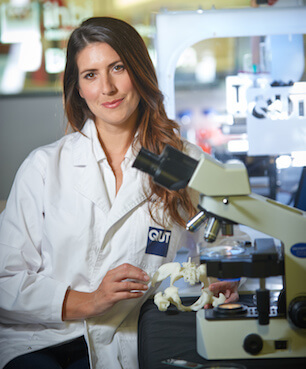One out of every 6,000 to 12,000 children born worldwide are affected by microtia, a condition where a baby is born without an ear or with an underdeveloped ear. While the ear canal isn’t usually affected, children with microtia suffer from moderate to severe hearing loss.

For years, researchers have been looking for a better solution to the current treatment — a silicone prosthesis or reconstructive surgery, which can lead to infection and scarring. Now, a revolutionary treatment is under development in Brisbane, where Mia Woodruff, associate professor at Queensland University of Technology (QUT) is developing the world’s first 3D-printed body parts.
Two years ago, Woodruff began using 3D-printed body tissue to heal patients with bone and cartilage injuries. “What we can do with our 3D-printing technology,” Woodruff explained, “is create a customized implant … which will fit perfectly and anatomically.” Instead of a plastic or silicone implant, Woodruff and her team at the Biofabrication and Tissue Morphology Group create body tissue with a 3D printer, “And, at the same time, we can add growth factors, which stimulate new tissue formation, and we can add stem cells from the same patient.”
Woodruff and QUT have teamed up with the non-profit Hear and Say to create the 3D prosthetic ears. Woodruff hopes to offer the prosthetic ears for sale within a couple of years, and eventually for less than the cost of a pair of glasses. The next step will be to create ears using 3D printing and including cartilage cells from the child’s own ear, which may be implanted into the body for a permanent ear construction. Woodruff also wants to use specially designed 3D printers to print biocompatible materials to augment other parts of the body and its organs.
It is life-changing technology, and the fact that this cutting-edge research is happening in Brisbane helps cement the city’s growing reputation as a global hub for groundbreaking, world-first medical research. When hosting a meeting in Brisbane, event organizers have access to the rich knowledge economy of the city, including some of the world’s top minds and institutions.
The work done by Woodruff and her team, and other leaders in the field, is forging the path toward a future where one day, we’ll see routine, on-the-spot 3D printing of anatomically precise replacement body parts, enabling a cost-effective, immediate solution to tissue loss.
At the end of 2016, the Herston Health Precinct in Brisbane announced the opening of a new Biofabrication Institute, which will image, model, and manufacture 3D patient-specific tissues in partnership with QUT and Metro North Hospital and Health Service. Co-located within the Royal Brisbane and Women’s Hospital and Herston Health Precinct, the institute is predicted to change the face of healthcare.
“The Herston Precinct is one of the largest integrated health, education and training, and research precincts in Australia and is currently undergoing large investment into clinical services expansion and clinically driven research institutes,” Woodruff said. “This is a truly innovative approach which ensures that scientists, clinicians, patients, industry partners, educators, and entrepreneurs are working closely together to really impact and improve healthcare solutions and ensure Australia is leading the world in this space. There’s simply no other place to be right now to realize this opportunity. It’s exciting times.”
Brisbane’s aptitude for attracting and encouraging innovation, industry leadership and emerging talent presents a unique chance to access world-class thought leaders who can enrich a conference experience with their expert knowledge, global networks and on-the-ground support.
For more information: Choose Brisbane — Kylie McKenzie; [email protected]; (617) 30006-6200.
Sponsored by


